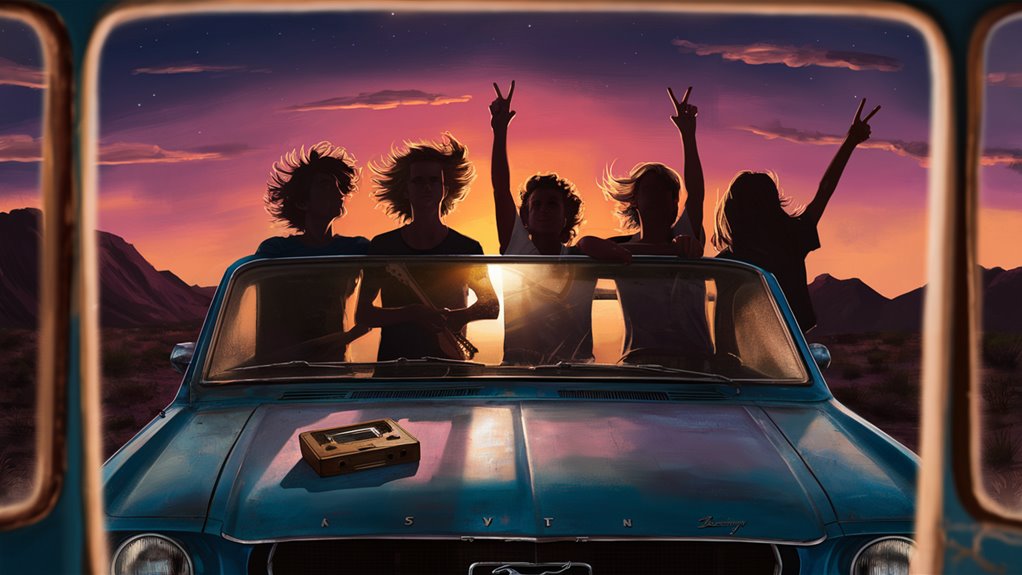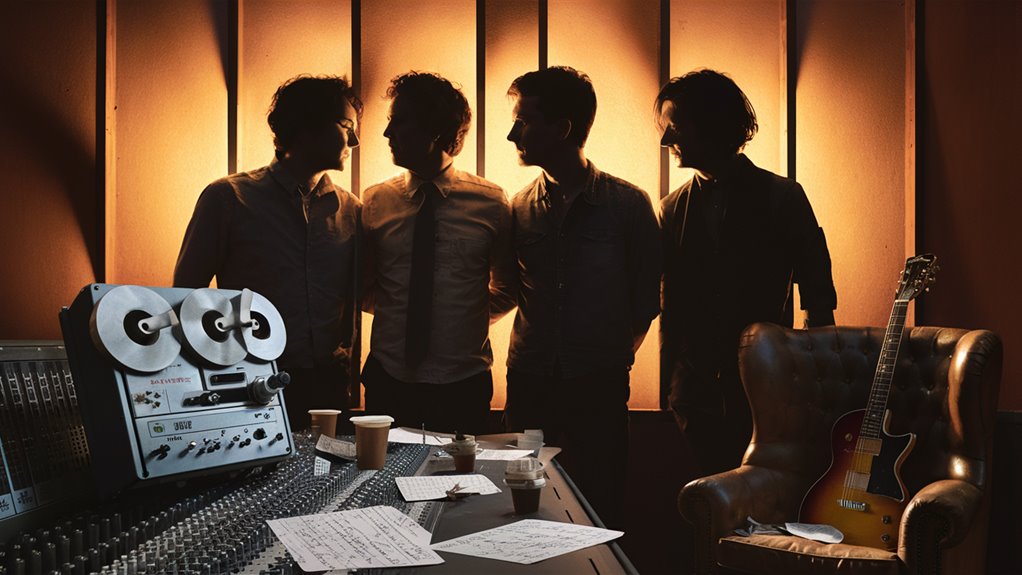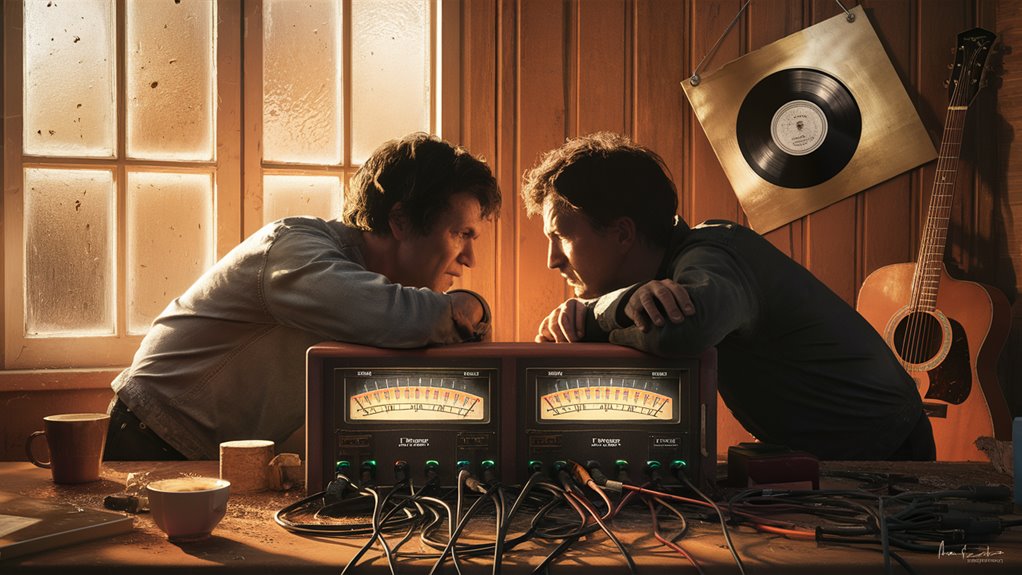
Hidden Gem Rock Ballads: Awesome Team-Ups

Timeless Music Ties
Rock music’s top finds often pop up from odd team-ups and close recording times. These rare music times catch the true heart of artists working as one, making something really cool. The magic is there when top stars try new things to find new art fields with other musicians.
Big Studio Times
The well-known 1969 Olympic Studios time between Robert Plant and Janis Joplin shows wild art skill. In the same way, David Bowie and Bing Crosby’s cool Christmas work shows how old and new music times can make magic together. These big team-ups show the power of artists joining.
Low-Key Hits and Acoustic Times
The Basement Tapes with Bob Dylan and The Band in Woodstock show the top skill of working together on songs. Johnny Cash’s standout take of Nine Inch Nails with producer Rick Rubin shows how low key music can change top songs. These close hits catch real times where artists share their hearts through music.
Unknown Music Jewels
Past the big hits are many unknown works that bring out the best in star performers. These cool finds have natural play and voice blends that only come from true artist ties. Each recording shares a tale of musicians finding shared art ways.
Legacy of Music Team-Ups
These team-up times keep shaping today’s music, showing that true art grows when stars get together. The tracks show rare looks into open moments between music greats, keeping their joint art for new fans to find.
Lost Hits Between Icons
Awesome Lost Music Hits: Unshown Works Between Rock Stars
Big Studio Times That Never Got Out
Lost recordings between known musicians are some of rock’s most asked-for finds.
These unshown works catch groundbreaking times that could have changed music’s path, but are still hidden from us.
Top Unshown Works
Plant-Joplin Olympic Studios Time (1969)
The awesome team-up between Led Zeppelin’s Robert Plant and Janis Joplin at Olympic Studios is one of rock’s biggest “what if” times.
Left bits show their strong voice play on “Piece of My Heart,” showing a hit that never was.
The raw power in these recordings shows the wild link between two of rock’s very different voices.
Clapton-Hendrix Lost Blues Time (1974)
A big unshown jam time between Eric Clapton and Jimi Hendrix stays one of music’s key lost finds.
The old tape, kept in private, holds a 15-minute blues play showing their mixing styles – Clapton’s careful, tune-filled skill beside Hendrix’s new, bold ways.
Bowie-Eno Berlin Hits (1977)
The unshown work between David Bowie and Brian Eno in Berlin is a key lost link in new music growth.
These before-“Heroes” recordings tried out electronic and chill sounds that later shaped the new wave move.
While bootleg fans say they have bits, full recordings are hard to find, leaving music folks to guess about their big new ways.
Odd Studio Team-Ups
Odd Studio Team-Ups That Changed Music’s Path
Famous Mix-Ups
David Bowie and Bing Crosby made one of music’s odd duets with their 1977 song of “Peace on Earth/Little Drummer Boy.” This cool team-up crossed a big old and new style gap, mixing Bowie’s new rock style with Crosby’s old pop ways. 호치민 가라오케 퍼블릭 장점
The holiday song, caught for Crosby’s TV show, grew past its fun start to become a go-to Christmas song.
Art Rock Meets World Music
The 1986 work between Kate Bush and Peter Gabriel on “Don’t Give Up” is a top show of art joining. Bush’s high voice mixed with Gabriel’s deep one made a chat in sound that lifted the song past its parts.
The song’s blend of art rock tries and world music touches set a plan for cross-culture music team-ups.
Songs That Go Past Style
Johnny Cash’s 2002 cover of Nine Inch Nails’ “Hurt” is maybe the most strong style change in today’s music. Producer Rick Rubin’s simple take left out the loud parts of Trent Reznor’s first, letting Cash’s old voice show deep heart pulls. Karaoke Experience for Your Guests
This bold new take turned an alt-rock song into a deep think on life and what lasts.
Classic Meets Metal
Metallica’s work with the San Francisco Symphony in “S&M” (1999) changed how we think of metal-classic mixes. The project showed how big music parts could raise heavy metal’s deep parts while keeping its bold edge.
This key show proved that very different music types can not just live together but make something bigger than their parts.
These bold team-ups keep shaping today’s artists, showing that true new art often comes from the most odd music team-ups.
Acoustic Times That Got Away
Lost Acoustic Times in Rock’s Past

Famous BBC Times
Led Zeppelin’s 1970 BBC acoustic show is one of rock’s most asked-for lost recordings.
The heart of this big time had an unplugged take of “Thank You” that is said to touch hearts more than the studio take. This rare acoustic set is a key find for music lovers and true fans.
The Nashville Chapters
A key yet unshown part in Beatles history came up in 1974 when Paul McCartney recorded close Nashville times with top local players.
These recordings had a simple acoustic take of “Band on the Run” boosted by true Americana sounds, like dobro and mandolin parts that changed the rock hit into a rootsy hit.
The Lost CSN Collection
Crosby, Stills & Nash’s unshown 1977 acoustic album is one of rock’s top buried finds.
The stored collection has new takes of “Suite: Judy Blue Eyes” beside many unheard new songs.
These recordings caught the big trio trying new art ways, showing raw creativity free of money limits or studio changes. The master tapes, still kept in CSN’s own safe, hold what many think is the group’s most true and new work.
One Time Only Shows
One Time Only Shows in Rock’s Past
Big Acoustic Team-Ups
Rare acoustic shows have made some of rock music’s top times.
The unplanned 1995 team-up between Robert Plant and Pearl Jam doing “Going to California” stands as a key mix of classic rock and new times.
This sudden join showed how simple setups can show music links over years.
Raw Acoustic Changes
Famous rock songs get a new life when played without loud parts.
The 2003 Grammy Awards had a big David Bowie and Dave Grohl team-up, giving a bare take that showed new deep parts of the words.
The Bridge School Benefit shows have had many cool acoustic times, like the 2014 Cornell-Vedder show that shared deep voice blends in their simplest form.
How One-Time Shows Work
These special live shows often make artists change how they sing and play.
The acoustic setup needs careful control and new ways, making new music takes that are very different from studio works.
Such shows show the true skill and many ways of known artists working in a close setting.
Unshown Basement Recordings
The Top Guide to Cool Unshown Basement Recordings
Old Underground Recording Times
Basement tapes are some of rock music’s most cool underground hits, catching raw art outside normal studio rules.
These close times write down open creativity and sudden work between known musicians, bringing out many unshown jewels that show true music tries.
Dylan’s Woodstock Past
Bob Dylan and The Band’s 1967 Woodstock times at the big “Big Pink” house are the top basement recordings. Over 100 unshown tracks came from these big meets, showing styles that go past normal ones and low key shows that shaped how music grew.
The easy times made room for bold song-making that mixed folk, country, and rock parts.
Known Underground Recordings
Bruce Springsteen’s Nebraska demos are another big mark in basement recording past. Caught on a simple 4-track tape player, these bedroom times showed the plain, close side of The Boss’s song-making.
The raw acoustic setups gave a dark back for Springsteen’s tale-telling, very different from his work with the E Street Band.
Early Beatles Starts
The before-Beatles recordings of Paul McCartney and John Lennon give rare looks into their starting years. These first home recordings caught early forms of future hits, showing the pair’s growing song-making skill.
The limits of basement recording gear made the sound more real, making artists count on true skill over studio ways.
Impact on Today’s Music
The mark of these old basement times keeps being felt in today’s music. The focus on true show and free art set by these recordings has led many artists to try similar low key ways, showing that strong music goes past tech limits.


